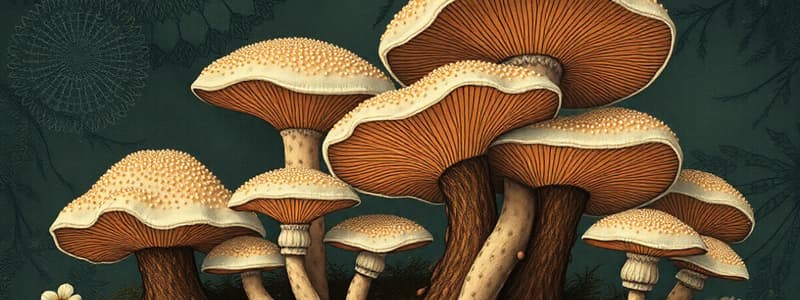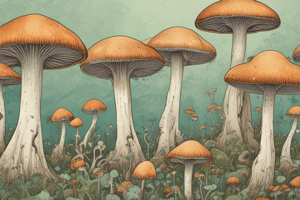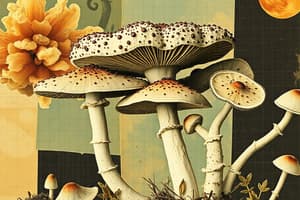Podcast
Questions and Answers
What is the primary mode of obtaining nutrients for fungi?
What is the primary mode of obtaining nutrients for fungi?
- Absorbing food through their cell walls
- Digesting food externally and then absorbing nutrients (correct)
- Producing food through photosynthesis
- Synthesis of nutrients from inorganic compounds
Which structure forms the feeding network in fungi?
Which structure forms the feeding network in fungi?
- Mycelium (correct)
- Spores
- Hyphae
- Cell wall
Which group of fungi is characterized by producing club-shaped basidia?
Which group of fungi is characterized by producing club-shaped basidia?
- Chytrids
- Basidiomycetes (correct)
- Zygomycetes
- Ascomycetes
Which type of fungi reproduce by cell division or budding?
Which type of fungi reproduce by cell division or budding?
What is a significant characteristic of mycorrhizae?
What is a significant characteristic of mycorrhizae?
Which fungi group includes organisms that form resistant zygosporangia?
Which fungi group includes organisms that form resistant zygosporangia?
Which characteristic is NOT associated with lichens?
Which characteristic is NOT associated with lichens?
What role do fungi play as decomposers in ecosystems?
What role do fungi play as decomposers in ecosystems?
What is the primary role of the cuticle in plants?
What is the primary role of the cuticle in plants?
Which plant groups primarily produce seeds?
Which plant groups primarily produce seeds?
What kind of structures do angiosperms utilize for reproduction?
What kind of structures do angiosperms utilize for reproduction?
In the process of fertilization in pine trees, where do the ovules develop?
In the process of fertilization in pine trees, where do the ovules develop?
In the alternation of generations, the sporophyte generation produces which type of spores?
In the alternation of generations, the sporophyte generation produces which type of spores?
Which feature distinguishes angiosperms from gymnosperms in terms of seed development?
Which feature distinguishes angiosperms from gymnosperms in terms of seed development?
What is a common feature of all vascular plants?
What is a common feature of all vascular plants?
Which component of flowering plants is responsible for trapping pollen?
Which component of flowering plants is responsible for trapping pollen?
Flashcards
What are the nutritional characteristics of fungi?
What are the nutritional characteristics of fungi?
Fungi are heterotrophic eukaryotes that obtain nutrients by digesting food externally and then absorbing it.
What is a mycelium?
What is a mycelium?
A network of thread-like filaments (hyphae) that make up the body of a fungus, responsible for absorbing nutrients.
How do molds reproduce?
How do molds reproduce?
Asexual reproduction in fungi involves the production of spores, often at the tips of specialized hyphae.
What are yeasts?
What are yeasts?
Signup and view all the flashcards
What are glomeromycetes known for?
What are glomeromycetes known for?
Signup and view all the flashcards
What is a lichen?
What is a lichen?
Signup and view all the flashcards
Why are fungi important decomposers?
Why are fungi important decomposers?
Signup and view all the flashcards
What are the benefits of mycorrhizae?
What are the benefits of mycorrhizae?
Signup and view all the flashcards
Pteridophytes
Pteridophytes
Signup and view all the flashcards
Spore production
Spore production
Signup and view all the flashcards
Sporophyte
Sporophyte
Signup and view all the flashcards
Ovary
Ovary
Signup and view all the flashcards
Cuticle
Cuticle
Signup and view all the flashcards
Stamen
Stamen
Signup and view all the flashcards
Gametophyte
Gametophyte
Signup and view all the flashcards
Angiosperm
Angiosperm
Signup and view all the flashcards
Study Notes
Fungi
- Fungi absorb nutrients after externally digesting their food.
- They are heterotrophic eukaryotes.
- Fungi are found everywhere.
- Fungi consist of thread-like hyphae that branch into a feeding structure called a mycelium.
- Hyphae are surrounded by a cell wall made of chitin.
- Fungi reproduce both asexually and sexually, producing spores.
Types of Fungi Reproduction
- Asexual Reproduction:
- Molds reproduce by producing spores, often at the tips of specialized hyphae.
- Yeasts reproduce by cell division or budding.
Five Groups of Fungi and Their Characteristics
- Basidiomycetes (club fungi): Have club-shaped spore-producing basidium; examples include mushrooms, puffballs, shelf fungi.
- Chytrids (water molds): Unique in having flagellated spores, they are decomposers and parasites.
- Zygomycetes: Form haploid spores in resistant zygosporangia; examples include fast-growing molds.
- Glomeromycetes: Soil fungi; form mycorrhizae, which are beneficial associations between fungi and plants.
- Ascomycetes (sac fungi): Have sac-like asci that produce spores; some are plant pathogens; part of symbiotic lichens.
Lichens
- Lichens consist of a mutualistic relationship between fungi and photosynthetic organisms (algae or cyanobacteria).
- The photosynthetic organisms live within a mass of fungal hyphae.
Parasitic Fungi
- Examples include Dutch elm disease, corn smut, and various skin infections (like ringworm and vaginal yeast infections).
Beneficial Fungi
- Mycorrhizae: Fungi provide essential nutrients to plants.
- Decomposers: Fungi are essential decomposers in ecosystems, consuming almost any carbon-containing substance.
- Practical uses: Fungi provide antibiotics, food, and are useful in research.
Mycorrhizae
- Fungi supply essential nutrients to plants.
- Mycorrhizae improve plant health by increasing drought and disease resistance, and by enhancing soil structure.
Plantae
Four Key Plant Adaptations to Land Life
- Dependent embryos: All plants
- Lignified vascular tissues: All vascular plants
- Seeds: Gymnosperms and angiosperms
- Flowers: Angiosperms
General Plant Features and Structure
- Reproductive structures (flowers): Contain spores and gametes
- Leaves: Carry out photosynthesis
- Cuticle: Reduces water loss; stomata: Allow gas exchange
- Stems: Support the plant and may perform photosynthesis
Plant Life Cycles (Alternation of Generations)
- Haploid Gametophyte: Produces eggs and sperm by mitosis.
- Fertilization: Results in a diploid zygote.
- Diploid Sporophyte: Develops from the zygote; produces haploid spores by meiosis.
- Spores: Grow into gametophytes.
Pine Tree Fertilization
- Reproductive stages are on sporophytes in cones.
- Ovulate cones bear ovules.
- Pollen cones produce haploid spores that develop into pollen grains.
- Pollination occurs.
- Meiosis occurs in the ovule.
Four Categories of Plants and Their Differences
- Bryophytes: Non-vascular plants
- Pteridophytes: Seedless vascular plants
- Gymnosperms: Seed-bearing, non-flowering plants
- Angiosperms: Flowering plants with seeds enclosed in fruits
Reproductive Structures of Flowering Plants
- Stamen: Stalk with an anther (pollen production) and a filament.
- Carpel: Stalk with an ovary (containing ovules) and a sticky stigma (pollen trap).
- Ovary: Chamber containing ovules where eggs develop.
General Features of Flowering Plants (Angiosperms)
- Gametophytes develop in flowers.
- Seeds are produced in an ovary and packaged inside a fruit.
Beneficial Effects of Angiosperms
- Major source of food for land animals.
- Provide most of our food and other commercial products.
Studying That Suits You
Use AI to generate personalized quizzes and flashcards to suit your learning preferences.




